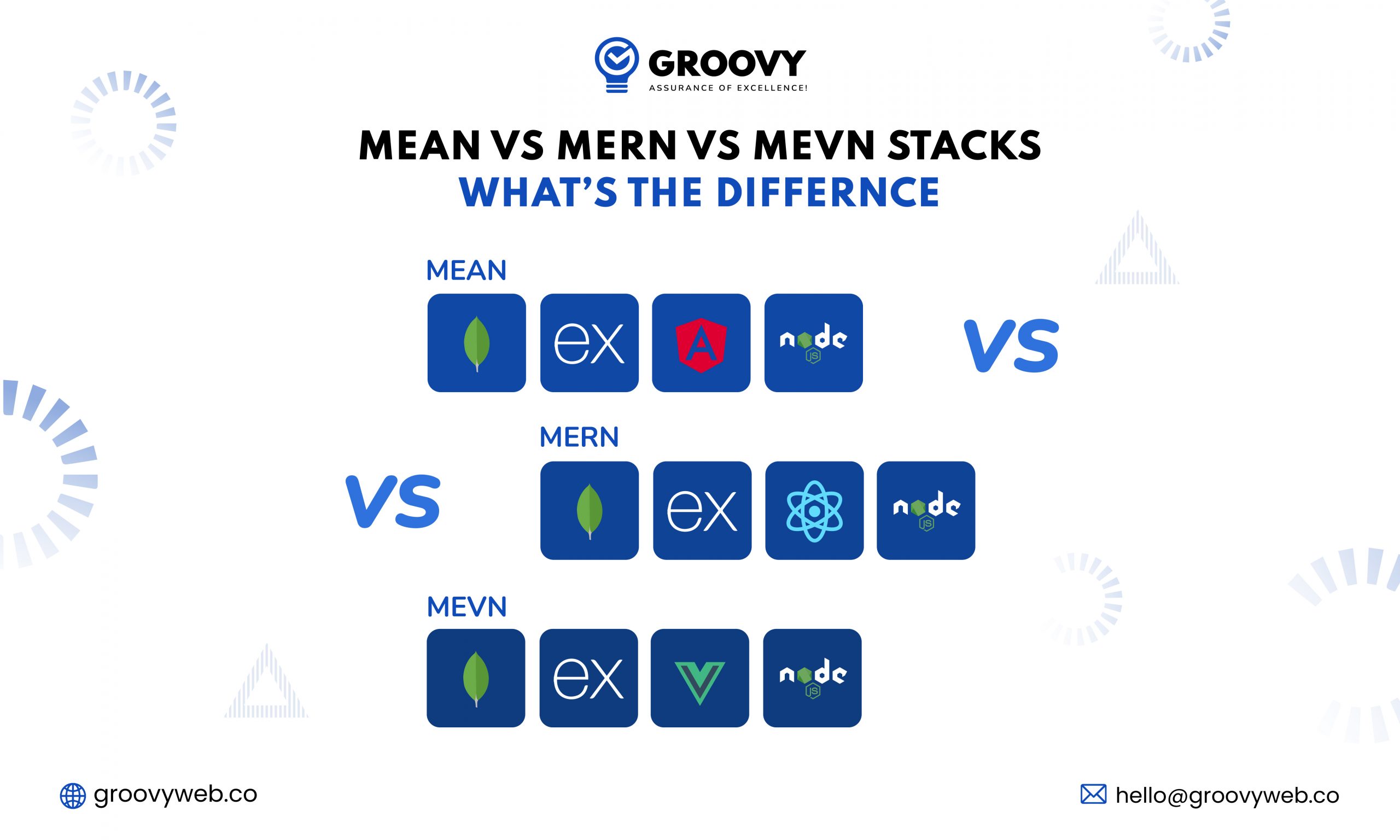MERN stack vs MEAN stack: Detailed Comparison
Sagar Patel
August 10, 2022 658 Views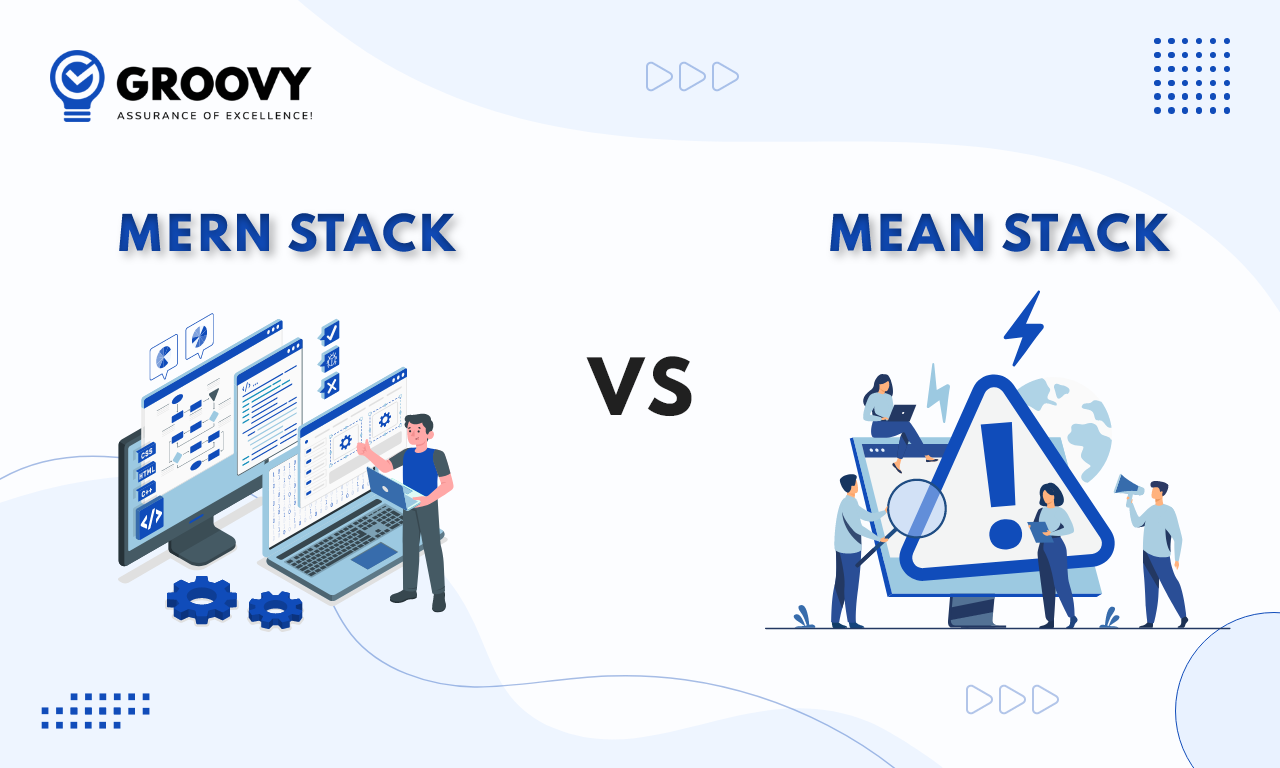
Quick Summary : This is a full comparison of the MERN Stack vs MEAN Stack. The final evaluation of your full project decides which technology Stack is required.
Mean Stack is one of the rapidly growing open source development frameworks enabling developers to construct a sophisticated web application extremely simply and quickly. The phrase implies that Stack denotes a group of gathered JavaScript-based frameworks to develop complex online applications.
MongoDB, Express.JS, Angular, and Node.JS are a collection of technologies that create a mix of MEAN Stack technology in Mobile and Web Applications.
The demand for technology has go-ahead developers to work on both Front-end and Back-end and much more. Developers these days grasp and can address faults across numerous streams of software development. Software development businesses are now carefully attempting to employ mean stack engineers who can construct the whole site or app without interruption.
Web Development technologies have undergone an exponential shift lately. The development technologies have evolved from backend development technologies like Java, PHP and others to frontend technologies like Angular JS, Node JS, React JS and others.
Since their beginnings, these technologies have continually been improved to increase coding efficiency and minimize code size.
MEAN Stack is one such group of technologies that have aided in lowering the development time to a considerable degree. MEAN Stack is a closely integrated collection of a NoSQL database technology named MongoDB and three JavaScript-based frameworks, Express JS, Angular JS and Node JS.
The key advantage of adopting the MEAN stack is that the full code is based on JavaScript. This decreases the learning time necessary for a rookie developer.
Moreover, with the startup culture thriving throughout the globe, short turnaround time and a lightweight application design have become the necessity of the day.
MERN Stack vs MEAN stack, mern stack development company assists in satisfying this demand. Chrome-based JavaScript is used in every code, including the web application server. As a result, memory use is reduced, and web response times are improved.
What is The Meaning of MERN Stack?
MERN Stack (MongoDB, Express, React, and Node.js) is the four primary technologies that comprise the Stack, and their initials form the acronym MERN.
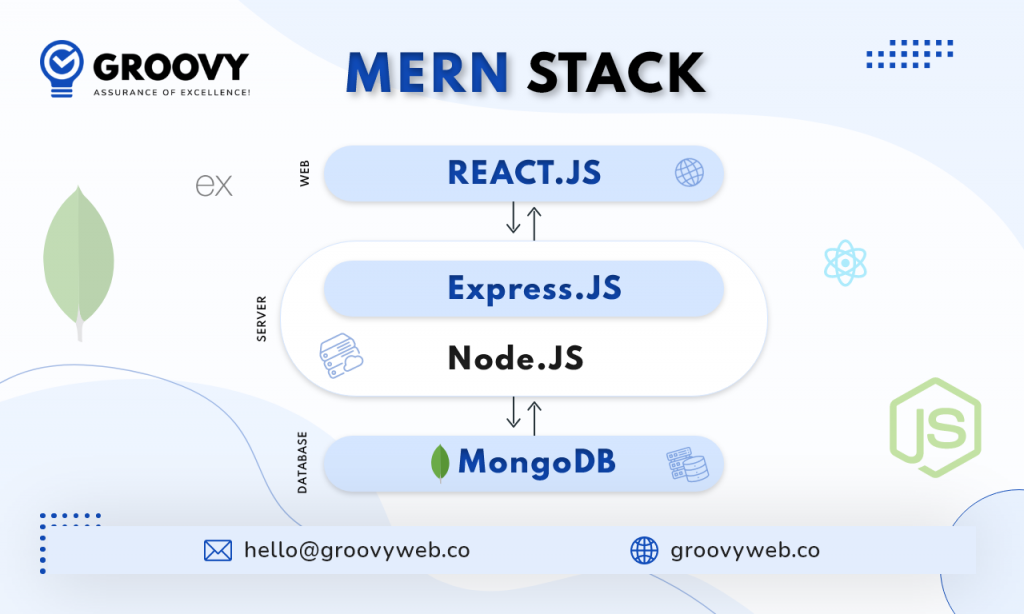
- MongoDB — document database
- Express(.js) – Node.js web framework
- React.js is a framework written in JavaScript that runs on the client.
- Node.js is widely considered to be the most advanced JavaScript web server.
Express and Node.js make up the application layer in the centre of the Stack. Express.js is a web framework that runs on the server, and Node.js is a platform for running JavaScript web servers that is both popular and powerful. No matter which option you choose, ME(RVA)N is the best method to work with JavaScript and JSON from start to finish in any situation.
What is MEAN Stack?
The MEAN stack is a framework for constructing web applications that are built on the programming language JavaScript. The acronym MEAN refers to the four core technologies—MongoDB, Express, Angular, and Node—used to construct the different levels of the Stack.
- MongoDB — document database
- Express (.js) is a web framework built on top of Node.js.
- Angular(.js) — a client-side JavaScript framework
- Node.js is widely considered to be the most advanced JavaScript web server.
There are other variants of the MEAN stack, such as MERN (which replaces Angular.js with React.js) and MEVN (which uses Node.js instead of Express.js) (using Vue.js). When it comes to developing online apps, one of the most widely used technological frameworks is known as the MEAN stack.
MERN Stack vs MEAN Stack: Which One is More Popular?
React, and Angular have comparable advantages and downsides in MEAN and MERN. Google Inc. backs Angular, while Facebook Inc. backs React JS. Choosing is difficult.
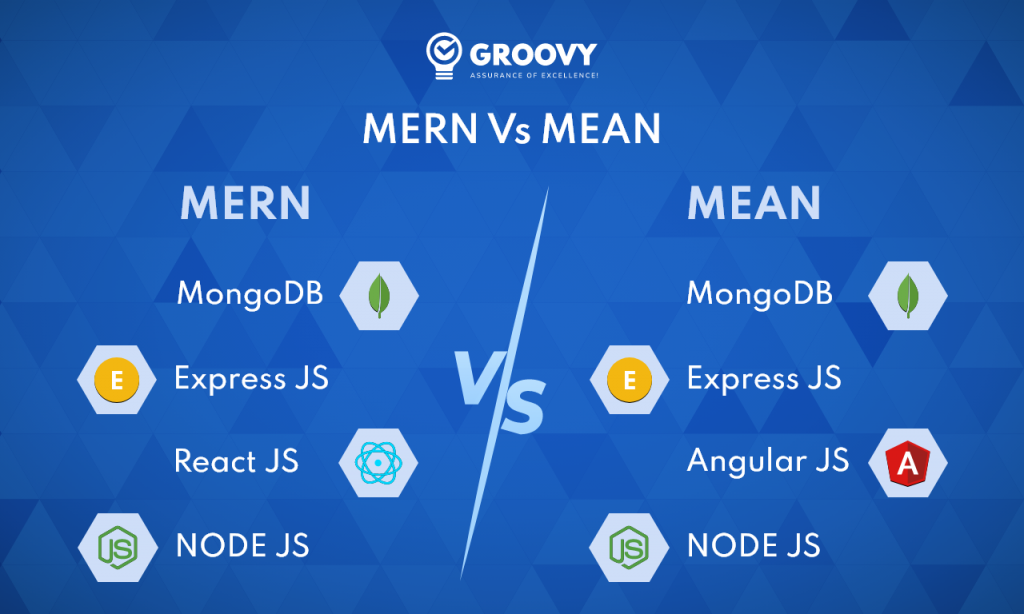
Decision-Making Factors
Entrepreneurs favour React.js vs Angular.js for maintenance and improvement. If you have a significant app change pipeline and long-term maintenance demands, consider MERN Stack. MEAN Stack Development is great for eCommerce.
MERN is your go-to framework for advanced but straightforward UI rendering. It creates and displays a screen frame fast for user interaction.
- Third-party support: Enterprise-level mobile applications may utilize third-party libraries. MEAN employs AngularJS, which has built-in HTTP and backend capability. React.js has similar libraries. MEAN’s plug-and-play approach to third-party extensions differs from MERN’s.
MERN vs MEAN deliver best-in-class security and scalability. Choose any MERN Stack is more secure than MEAN Stack Development since it’s scalable.
- Niche projects: MERN Stack lets you build and deploy CRUD apps. React handles fast-changing data efficiently and has an attractive UI. MERN is best for a single-page app or mobile app.
MERN Stack vs MEAN stack: Detailed Comparison
MEAN Stack and MERN stack are two examples of full-stack development frameworks. Let us examine the differences between the two—most open-source JavaScript frameworks leverage MEAN Stack.
With the help of MongoDB, Express, AngularJS, and Node.js, developers working for the best mobile app development firms may create contemporary web apps. Its speed, dependability, and scalability have made MEAN Stack popular. The MERN stack, the Micro-Era Enterprise Node (MERN) Stack, is the second most popular open-source software stack. MongoDB, Express, React, Redux, or Angular 2+ are all components.
Scalability in MERN Stack vs MEAN Stack
MERN stack
The design of SaaS applications has to be adaptable and flexible since SaaS apps are constantly being updated. Node.js, which maximizes processing capabilities, and MongoDB, the NoSQL database, which is extremely scalable and compatible with cloud storage, are both components of the MERN stack.
Together, these components make the MERN stack very flexible and scalable. Components built using React.js are extremely reusable, which makes it simpler to put best practices into action. Additionally, this increases the overall productivity of the developers and significantly decreases the time required for turnaround.
MEAN Stack
The code generated by React technology may also be reused for developing cross-platform mobile applications. These production-approved reusable components enable the smooth and rapid creation of SaaS modules, enabling you to generate a production version that is useable in the shortest amount of time possible.
Automated quality assurance will be maintained in a web application built using MEAN. Similarly, when a component begins to operate independently, the developer will have fast access to the relevant information.
The ease with which quality checks can be maintained is one of the primary motivating factors for businesses’ decisions to engage MEAN stack engineers. Coordinating quality assurance testing with the development stage in a way guaranteed by the MEAN stack is the technique that yields the best results.
Learning curve & Syntax in MERN Stack vs MEAN stack
In the contest between MEAN and MERN, the learning curve occurs to be a significant point of differentiation.
The MEAN stack is a framework that comes pre-configured. Because of this, newbies may find the framework to be difficult to master. Learning how to use the framework with MERN Stack is not that difficult.
This is because ReactJS offers extensive documentation, making it simple for developers to get all the knowledge they want. Because the learning curve for the MERN stack is not as high as it is for other stacks, it is simpler to recruit engineers to work with MERN.
Winner: MERN Stack because using it entitles you to access adequate documentation, making it easy to get familiar with the framework.
Architecture in MERN Stack vs MEAN stack
React.js Development is used for the frontend display tier, Express.js and Node.js are used for the application layer, and Node.js and Express.js are used for the database tier. MERN stack web development, mean stack app development is a complete stack and follows the typical three-tier architectural design (MongoDB).
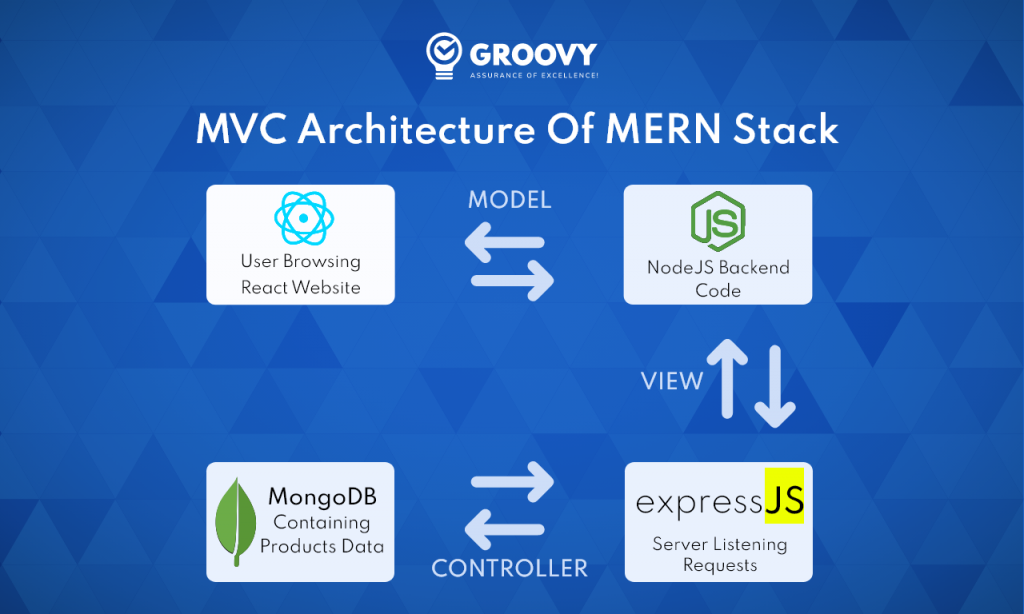
The MEAN stack’s architectural framework supports the Model View Controller, or MVC, architecture. All of the MEAN components are open-source and free to use. It is simple to comprehend and straightforward to put into action. It makes it easier for developers to tailor the application to meet specific client needs. It transfers data via JSON and has a vast node module library at its disposal.
Performance & Speed in MERN Stack vs MEAN stack
MEAN Stack
To provide a seamless transition from the backend to the frontend side, each component of the MEAN stack interacts with the other components. To begin, Node.js makes it easier to structure a server-side script written in Java. Second, Angular.JS, which Google supports, makes it possible to develop a single-page application so that the application is informed if there is any resistance. After that, the document-oriented database is created by Mongo DB, which Express follows. JS framework is built on Node.js and is used to construct web apps. The most important part of the MEAN stack is called Angular.js, built on the MVC framework. This ensures that abstraction is maintained in the code at a good pace, improving large-scale applications’ operation.
MERN stack
Each component, similar to the MEAN stack, engages in cooperative communication. It was first developed using Mongo DB and helps store JSON data while providing auto scalability for cloud-native apps.
Express.JS is an application that runs on the backend, enabling HTTP replies to map URLs to the server side. React.js is a frontend JavaScript that makes writing code in HTML easier via improved communication with the client. In the end, Node.js produces a well-written JSON application that runs quickly. This Stack, on its whole, is very helpful for the expedited creation of applications on a smaller scale.
MERN stack is superior to the MEAN stack in speed, smoothness, and communications. Performance-wise, working- and functioning-wise, the MERN stack is considerably better than MEAN Stack.
Libraries & Dev Tools in MERN Stack vs MEAN stack
The in-built React library of the MERN stack gives developers access to high-end technologies that simplify and add joy to the software creation process. Developers have access to a veritable treasury through the React libraries, particularly in design. Model-view-controller: The MVC design of the MERN stack ensures a seamless development process, which in turn enables developers to concentrate on enhancing the app’s functionality.
The discussion on whether the web framework is superior, Angular or React, is ongoing and lies at the heart of the MEAN vs MERN argument.
Although Angular.js Development has seen a great deal of success in the past, it seems that React is now in the lead and is undeniably a popular choice among software developers. This is shown by the findings of Groovy Web, mern stack tutorial Developer Skills Report, which reveal that 32.3% of developers are interested in learning React.
In contrast, just 27% of developers have the same interest in Angular. This might be seen as evidence that the MERN stack is now riding a wave of increased popularity due to its integration with React. Regarding most projects, however, selecting between the MEAN stack and the MERN stack is determined by more factors.
Community in MERN Stack vs MEAN stack
MERN Stack is a frequent alternative to MEAN Stack Development. In this approach, the standard Angular.js framework is switched out for React.js, which results in a far more streamlined and straightforward development process. The term “MERN” is an abbreviation that refers to a collection of technologies, namely MongoDB and Express.
Extensibility in MERN Stack vs MEAN stack
Commercial and open-source MongoDB installations have increased across several sectors due to the rising trend toward Big Data and NoSQL databases such as MongoDB. Fast and sophisticated data analytics and scalability are the primary goals of MongoDB. Query optimization, isolation, and scalability feature it can do for users working with large amounts of data.
Only MongoDB enables SQL-based queries, which makes it perfect for complex data analytics and ad hoc data management. In industries including banking, media, entertainment, online shopping, video games, SaaS and health tech, MongoDB has been used for many applications.
For cloud-based applications, MEAN is an open-source web stack. Applications built on the MEAN stack are ideal for cloud hosting because they are adaptable, scalable, and extendable. In addition to the web server, the Stack contains a database that can be scaled up or down to suit surges in demand. The benefits of the cloud are immediately apparent when a MEAN application is launched.
Universality in MERN Stack vs MEAN stack
The MEAN stack and the MERN stack have a lot of characteristics in common with one another. However, the MERN stack employs React instead of Angular tools to construct frontend web applications, while the MEAN stack uses Angular tools. This is the sole distinction between the two.
Error Handling Capabilities in MERN Stack vs MEAN stack
React, which is a framework built on JavaScript, is what MERN employs. However, Angular employs Typescript in its development. JavaScript can be typed, while Typescript can only be typed. This language is built statically and provides static typing, classes, and interfaces for its users. It helps identify frequent faults, which increases the likelihood that you will write code free of bugs.
When to use MERN Stack over MEAN Stack: Use Cases
If your code could be upgraded and managed more easily. Because it uses Angular, the MEAN stack simplifies the process of managing and updating your code. Because it is a comprehensive and well-organized framework, Angular can provide superior support for the MVC design. Using an intermediate layer, you can separate the code linked to the database from the code related to the user interface, making it much simpler to maintain and update your code.
When to use MEAN Stack over MERN Stack: Use Cases
The mern vs mean stack offers more sophisticated functionalities, some of which may make development much quicker and simpler. In addition, it harnesses the power of contemporary single-page apps by eliminating the need to refresh a web page for each server, as is the case with most conventional online applications.
Conclusion
Each of the MEAN and MERN stacks has a lot of similarities, and in addition, they both have numerous benefits to offer. They are different regarding various criteria used to make decisions; for instance, the MERN stack is superior for mobile development, while the MEAN stack provides more productivity, etc.
In the final analysis, your entire project needs will be the primary factor in determining the technological Stack you choose.
Written by: Sagar Patel
Sagar Patel is the CTO and Co-founder of Groovy Web. He was involved in the telecommunications & Automation industry during his early career. Still, due to his attitude toward learning anything new and mastering it, he now works as a CTO for Groovy Web. Through their business mindset and logical approach, they have taken their company to the next level; His responsibilities now include all aspects of the business. Among them are finance, process design, and development.
Frequently Asked Questions
We hope these clear your doubts, but if you still have any questions, then feel free to write us on hello@groovyweb.coHow long does it take to build a mobile app?
Figuring out how long it takes to develop a mobile app will depend on various factors like the development platform, the complexity of the design, the developer's experience level, features, and functionality, testing, and many more. Contact us with your requirement to know the estimated time.
Why Choose Groovy Web For Mobile Application Development Project?
We are a GoodFirm and Clutch certified custom software development company with 7+ years of experience helping businesses develop. Professionals in mobile app development, web development, and custom software development for the IT, e-commerce, healthcare, and medical industries. We have delivered 500+ customer solutions for companies. Our client has a quality product with satisfaction and timely delivered projects, and they have seen significant investment since the company developed software.
How much does it cost to develop a Mobile Application?
Starting from $1K, Yes! That's true; Mobile App development begins with the lowest as $18/ Hour with Groovy. The cost of building any apps depends on different factors such as app complexity, UI/UX designs, feature set, etc. So, It's necessary to work on the scope document to get a accurate cost for your Mobile App development.
Related Blog

Ashok Sachdev
How to Build An eCommerce Node Js Web Application
Web App Development 23 Aug 2022 12 min read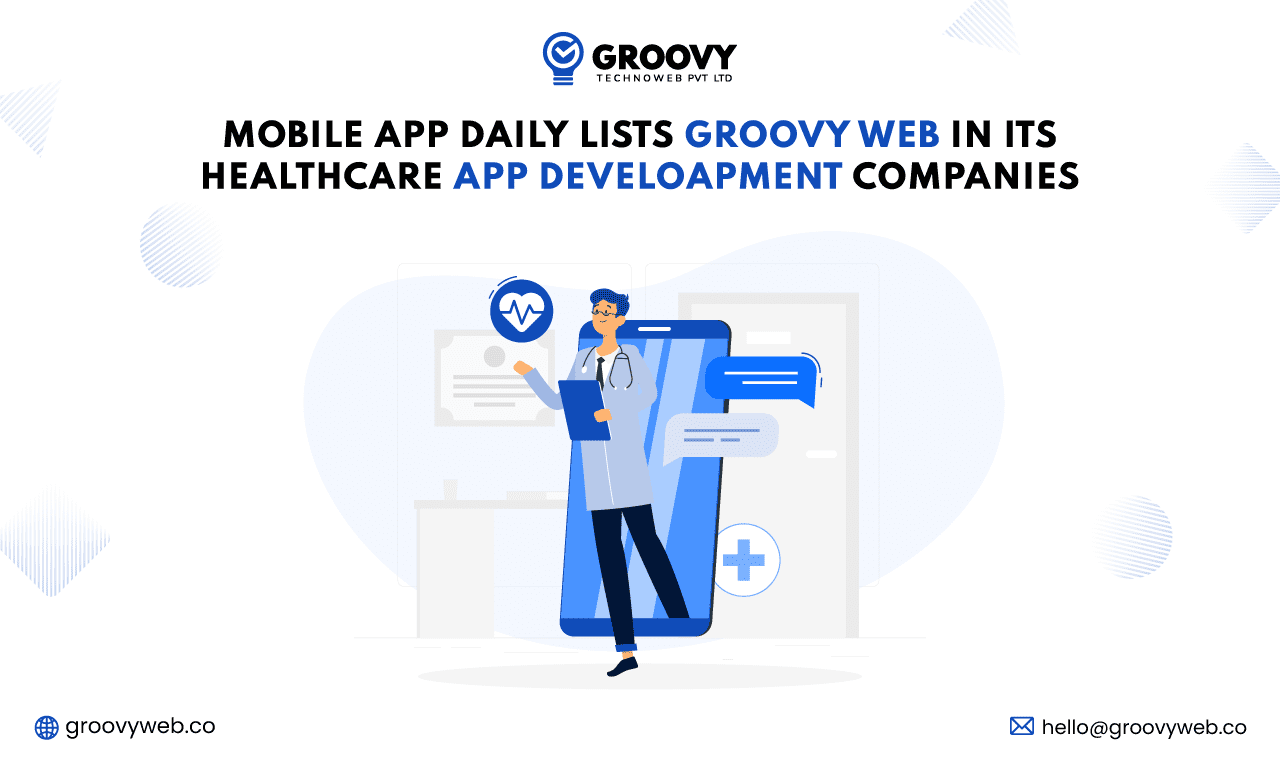
Kartik Bhaviyash
MobileAppDaily Lists Groovy Web in its Healthcare App Development Companies 2023
Achivements 25 May 2023 2 min readSign up for the free Newsletter
For exclusive strategies not found on the blog
